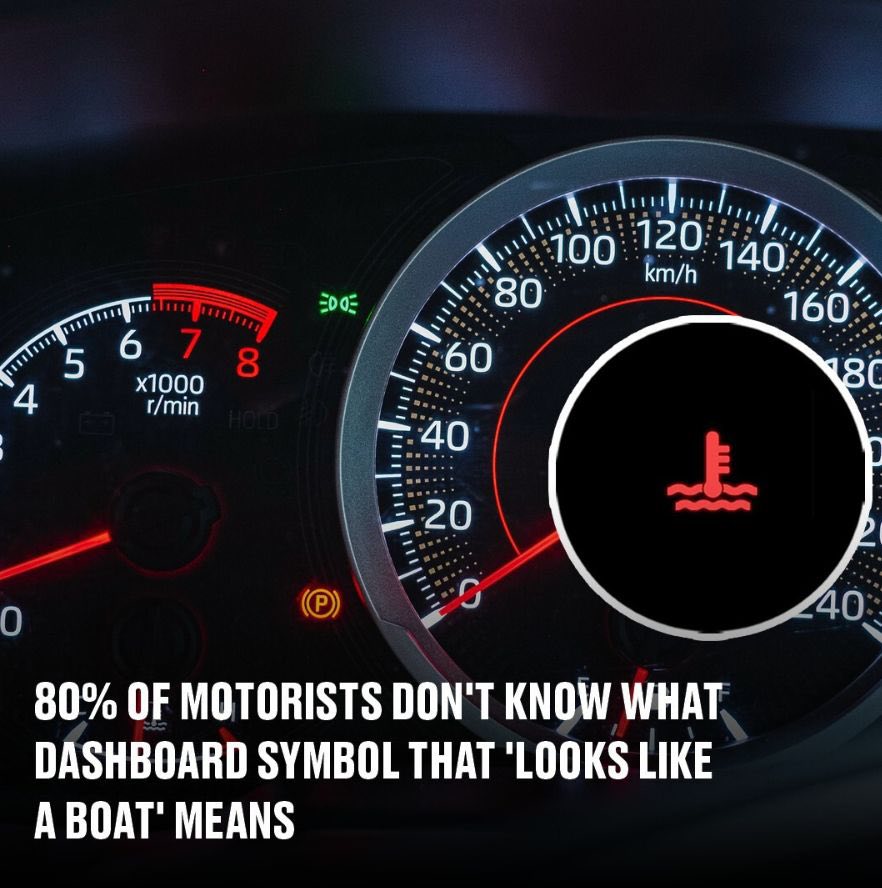Eighty percent of drivers are unaware of the meaning behind a particular dashboard symbol that many say “looks like a boat.” Let’s face it—modern vehicles are loaded with dashboard indicators, and keeping track of what each light means can be overwhelming. Most of us are familiar with common warnings, like the low fuel light or the seatbelt reminder, but some symbols remain a mystery until they suddenly light up, leaving drivers puzzled and sometimes panicked.

One of the more confusing symbols is the one that resembles a thermometer sitting on wavy lines. It’s often mistaken for a boat or a sailboat icon, which has led to plenty of jokes and confusion online. A viral post on X (formerly Twitter) highlighted this issue when a user shared an image of their dashboard with the symbol illuminated. “What does this light mean?” they asked. The responses were a mix of humor and genuine attempts to help. One person joked, “That’s the ‘pirates approaching’ warning. Better start paddling!” Another said, “Looks like smooth sailing ahead.”
But despite the jokes, the reality is far more serious. That little symbol isn’t about pirates or smooth sailing; it’s the engine coolant warning light. A study by ATS Euromaster revealed that a staggering 80% of drivers didn’t recognize what this light indicates. Ignoring this warning can lead to catastrophic engine damage and potentially thousands of dollars in repair costs.
So, what does the symbol actually mean? The engine coolant warning light signals that your car’s engine is overheating or that there’s an issue with the cooling system. It could mean the coolant level is too low, there’s a leak in the system, or the sensor is malfunctioning. Whatever the cause, it’s not something you can afford to ignore.
When this light turns on, here’s what you should do immediately: According to Eden Motor Group, “If the light is red, you should pull over as soon as it is safe to do so and switch off the engine.” Driving with an overheating engine is a surefire way to cause severe damage, including warping the engine block or blowing a head gasket.
After pulling over, you should pop the hood and let the engine cool down for at least 30 minutes before attempting any checks. Never open the coolant cap while the engine is still hot, as pressurized steam can cause serious burns. Once the engine has cooled, check the coolant reservoir. Most coolant tanks have clear markings indicating the maximum and minimum levels. If the coolant level is low, carefully top it off with the appropriate type of coolant recommended by your car’s manufacturer.
But low coolant isn’t always the root of the problem. Eden Motor Group notes that the issue could also stem from a faulty sensor or a leak somewhere in the cooling system. A common culprit is a cracked hose, a hole in the radiator, or even a malfunctioning water pump. In some cases, you might be able to spot the leak by looking for visible drips, listening for hissing sounds, or detecting a sweet smell coming from the engine bay.
If you’re not confident in diagnosing the issue yourself, it’s best to call roadside assistance or have your car towed to a qualified mechanic. Continuing to drive with a malfunctioning cooling system risks irreversible damage to your engine.
It’s worth noting that regular vehicle maintenance can help prevent these issues. Checking your coolant levels periodically, inspecting hoses for cracks, and scheduling routine inspections can go a long way in ensuring your cooling system functions properly. Prevention is always cheaper than repair when it comes to engine problems.
In short, that dashboard symbol that looks like a boat isn’t nautical in nature at all. It’s a thermometer over wavy lines, and it’s warning you that your engine is either too hot or your coolant system is compromised. When you see this light, don’t panic—pull over safely, let the engine cool, check your coolant levels, and call for help if needed. Ignoring it isn’t an option unless you’re ready to foot a hefty repair bill.
Understanding your car’s dashboard symbols isn’t just about preventing damage—it’s about safety. Being informed means you can act quickly and responsibly when something goes wrong. So, the next time you see that little boat-like symbol pop up, you’ll know exactly what to do: stop, check, and act before it’s too late.





